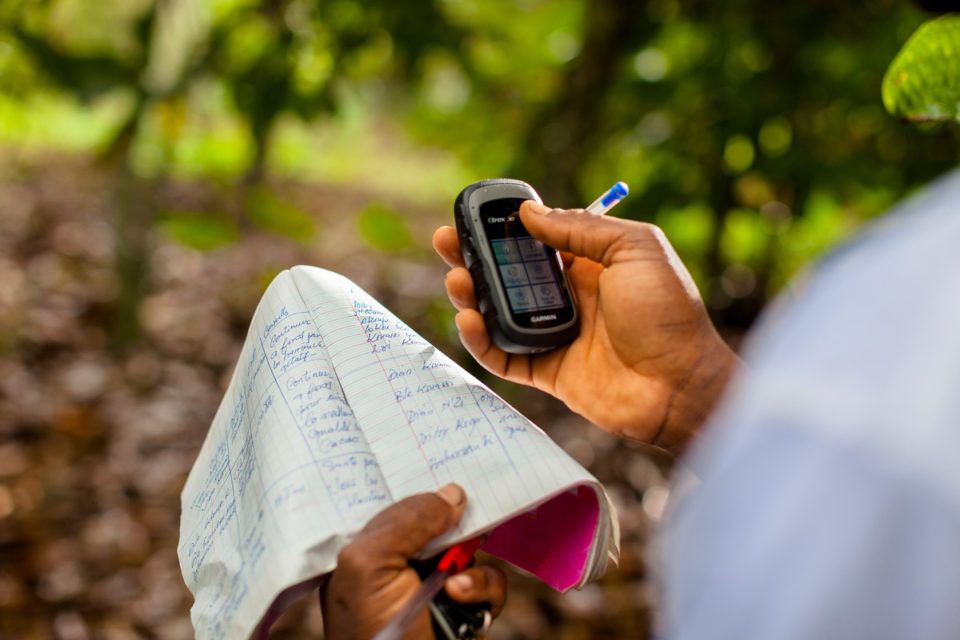For a large, global agribusiness operating across continents and agricultural commodities like Olam International, accessing detailed information about the people and operations supplying the business, is a struggle.
Olam, which is headquartered in Singapore but operates in 70 countries, grows, sources, processes, manufactures, transports, trades and markets 47 different agrifood products. These include commodities like coffee, cotton, cocoa, and palm oil, which are frequently grown by smallholder farmers in some of the poorer, more remote parts of the world. With increasing consumer scrutiny about where food comes from, from an ethical and sustainability standpoint as well as a safety standpoint, understanding in detail how operations in your supply chain are running is of increasing importance.
Limited internet connectivity, poorly educated farmers, and challenging climates can make this an uphill battle, however, and until now, Olam has relied on its staff in the field to collect information with pen and paper, according to Simon Brayn-Smith, the director of Olam’s new technology platform, the Olam Farmer Information System (OFIS).
To meet this challenge, Olam created OFIS, a technology platform aiming to provide smallholder farmers with a variety of resources to help sustain and grow their operations, as well as give Olam the information it needs to assure its customers about the provenance of their products. OFIS now has 100,000 farmers signed up.
“OFIS solves the information issue by providing a revolutionary tech innovation for collecting and analyzing first mile data,” Brayn-Smith told AgFunderNews. “We are able to register thousands of smallholders, GPS map their farms and local infrastructure, collect all types of farm gate level data such as the age of trees, and record every training intervention.”
OFIS offers registrants a variety of features, including data management, geotagging for traceability, and ways to reduce supply chain risk in a variety of crops like coffee, cocoa, cashews, hazels, palm, pepper, rice, and rubber.
In addition to standard data collection and analysis, the platform’s features can be customized to suit each smallholder farmers’ unique needs. Each registrant can obtain a personalized farm management plan with advice delivered via text message on how to boost yields and margins for each crop and each plot. So far, over 10,000 farmers have obtained unique plans, according to company reports. The registrants can also be paid via OFIS into a mobile wallet that also allows them to create and manage their credit histories, potentially enabling them to apply for loans, something few smallholder farmers would have ever been able to do before.
Cooperative and farmer group members receive an additional bevy of resources, including stock level management, creditor and debtor oversight, farm-to-fork traceability reports, and detailed reports on business activities. In fact, OFIS’ Internal Management System was designed with an eye toward capacity-building to help support agriculture growth in smallholder regions.
Other OFIS features directly target the environmental impact of farming and Olam has with a number of partners and NGOs on this component, according to Brayn-Smith.
“The platform allows for greater insight to tackle issues from poor yields to climate change and child labor,” he explained. “And by geotagging each bag of produce, we can trace it through the supply chain.”
There’s also an SMS function that allows users to contact one another directly with tips about pricing, weather, and production.
With each new registrant, Olam obtains a better understanding of the agriculture industry around the globe, including how technology is shaping and driving the next phase of food production. In 2016, the company set up a ‘Digitalising Olam Task Force’ to identify and capitalize on new opportunities in the agtech sector. As part of the Task Force, they’ve launched eight initiatives that will cultivate a “digital first” culture in the company while hopefully posturing Olam to be at the forefront of transformative and potentially disruptive technologies.
Of course, that can be easier said than done. Something Brayn-Smith fully appreciates.
“We would never pretend to have all of the answers in-house and so it’s important for us to be engaged in order to understand what is out there, to look at some of the innovation and to identify potential partners. It can be difficult to cut through a lot of the noise being built up in this sector and to identify the platforms or partners that will be around over the long term, but that is part of the challenge of working in such a fast-moving sector,” he said. “With the success of OFIS internally, the depth of functionality that we have built and the investment that we have so far put into the system, we are also looking at options for engaging in the market in a different way.”
Did Olam look externally for a solution before building its own platform? Yes, but it came up short, according to Brayn-Smith.
“We started building OFIS in-house several years ago as, at the time, we couldn’t find a solution on the market that met all our needs,” he said. “Clearly since then, the number of ‘outside’ solutions has increased dramatically with some very good offerings on the market.”
Brayn-Smith wouldn’t rule out the possibility of Olam investing directly in a relevant startup, but for now, harnessing OFIS’ full potential is the company’s main priority, while he is always keen to see what’s happening in the marketplace.
Justin Oberman, an entrepreneur in the space, is encouraged by the development of OFIS.
“We are encouraged by Olam’s progress with its Farmer Information System because it demonstrates the financial, operational, and agricultural value of being able to connect to growers. We think that it also points out the space for the tool we are exploring: one that will engage all supply chain players and be fully functional on feature phones.”
So far, Olam has implemented the platform in 21 countries and nine languages. Its latest goal is to have 500,000 OFIS farmers by 2020.
*Additional reporting by Louisa Burwood-Taylor




